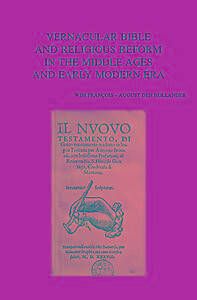
- Retrait gratuit dans votre magasin Club
- 7.000.000 titres dans notre catalogue
- Payer en toute sécurité
- Toujours un magasin près de chez vous
- Retrait gratuit dans votre magasin Club
- 7.000.0000 titres dans notre catalogue
- Payer en toute sécurité
- Toujours un magasin près de chez vous
Vernacular Bible and Religious Reform in the Middle Ages and Early Modern Era
94,00 €
+ 188 points
Description
The central focus of this book concerns vernacular Bibles in various regions of (late) medieval and early modern Europe, as well as the religious and cultural circumstances in which these books found their origin. The contributions represent a cross-section of several research traditions that show an interest in vernacular Bibles. The volume includes articles that demonstrate how vernacular Bibles were liable to censorship measures, viz. Francesca Tasca's contribution on Peter Valdes of Lyons, and Gigliola Fragnito's on post-Tridentine Catholic Europe. Other essays, in contrast, inspired by a social-historical approach, emphasize that laypeople in the late Middle Ages and Early Modern Era found ways to read the Bible and other religious works 'anyway' and that they were hardly hindered by bans instituted by ecclesiastical or secular governments. Two authors who take this position are Andrew C. Gow and Margriet Hoogvliet, who also question the paradigm that the Protestant Reformation was the first to open the Bible to the laity. Suzan A. Folkerts brings this intuition into practice by studying printers' choices as well as provenance data in books containing the Epistle and Gospel readings from Mass published between 1450 and 1550 in the Netherlands. The volume also contains contributions that focus on that book beyond Western European (Romania: Emanual Conac, Eugen and Lucia-Gabriela Munteanu and Scandinavia: Jonatan Pettersson). In this regard, attention is paid to the (pre)confessional character and literary choices that are constitutive for the text. The confessional Era and its implications in the political field are central to Elizabeth Hodgson's study of 'David's Psalms' in Reformation England and France/Switzerland. The 'post-confessional' eighteenth century Enlightenment Bible - rooted in the Catholic tradition - by Isaac-Joseph Berruyer is the object of an essay by Daniel J. Watkins. Finally, Kees Schepers devotes a study to 33 drawings made by the Brussels canon regular Gielis vander Hecken.
Spécifications
Parties prenantes
- Editeur:
Contenu
- Nombre de pages :
- 313
- Langue:
- Anglais
- Collection :
- Tome:
- n° 287
Caractéristiques
- EAN:
- 9789042934313
- Date de parution :
- 05-07-17
- Format:
- Livre broché
- Format numérique:
- Trade paperback (VS)
- Dimensions :
- 157 mm x 239 mm
- Poids :
- 589 g

Les avis
Nous publions uniquement les avis qui respectent les conditions requises. Consultez nos conditions pour les avis.





